Finance in Hospitality: Financial Analysis and Strategy Report
VerifiedAdded on 2020/01/21
|19
|5301
|51
Report
AI Summary
This report offers a comprehensive analysis of financial management within the hospitality industry. It begins by evaluating internal and external finance sources available to businesses, including owner's funds, bank loans, and government grants, while also examining methods for generating income, such as providing event spaces and renegotiating contracts. The report then delves into cost elements (direct and indirect) and explores methods for controlling stock and cash through techniques like EOQ, ROP, and JIT. Budgetary control processes, including forecasting and variance analysis, are discussed. The report also covers the source and structure of trial balances, along with ratio analysis to assess financial performance, and concludes with a break-even analysis, cost-volume relationships, and short-term management decisions. The report includes tables for adjustments and financial statements, offering insights into strategic recommendations for improving future performance. This report is contributed by a student to Desklib, a platform providing AI-based study tools.
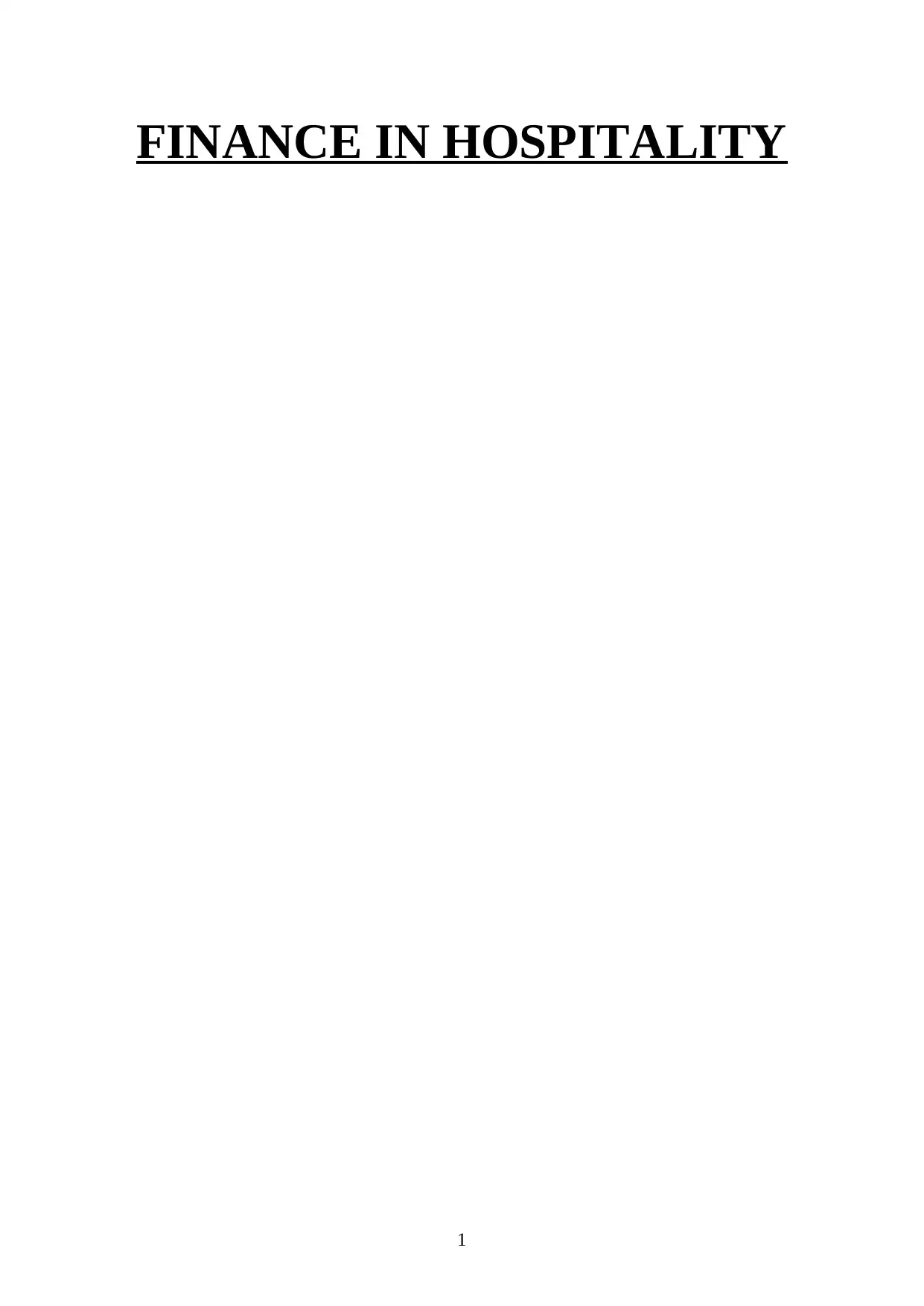
FINANCE IN HOSPITALITY
1
1
Paraphrase This Document
Need a fresh take? Get an instant paraphrase of this document with our AI Paraphraser
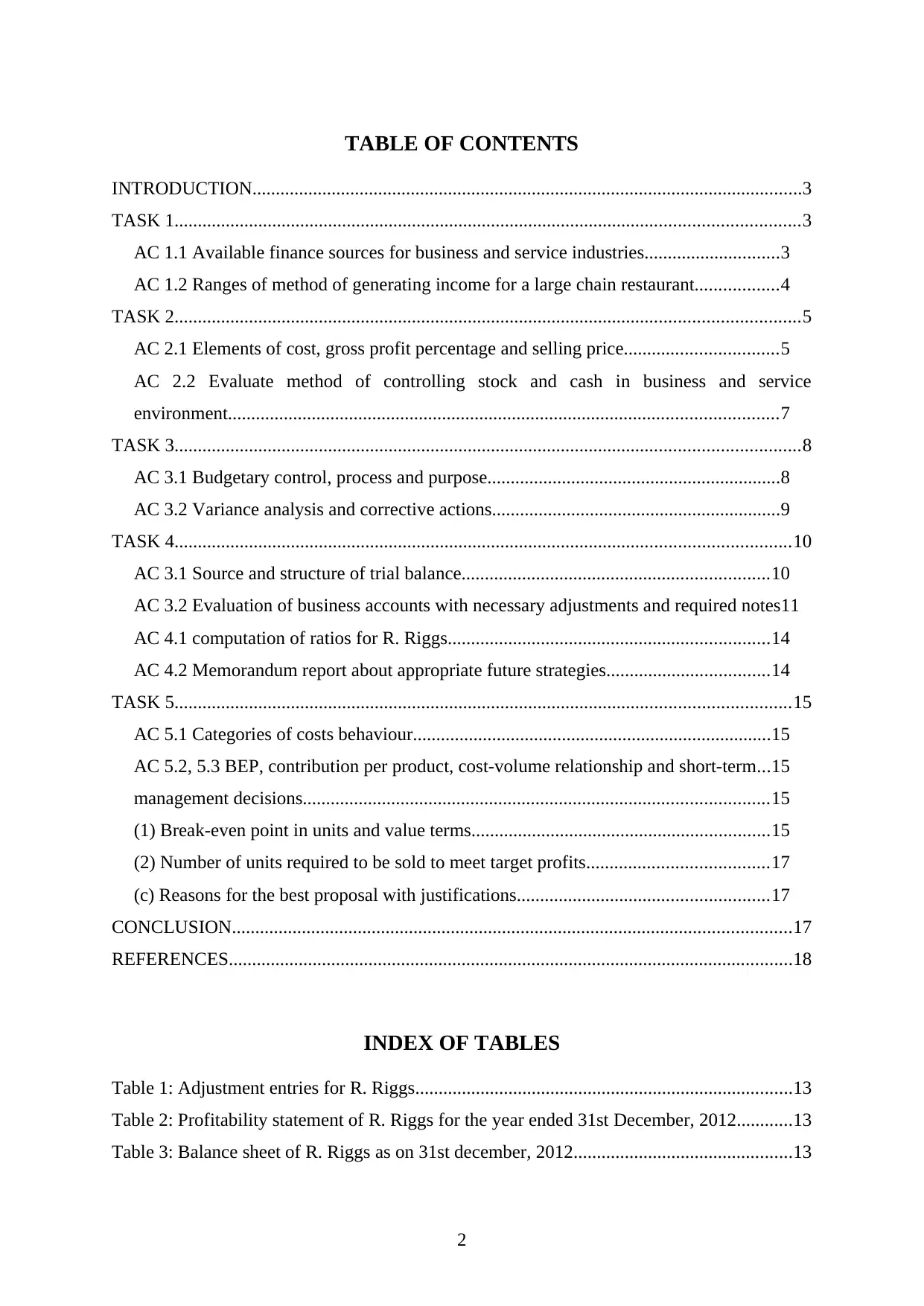
TABLE OF CONTENTS
INTRODUCTION......................................................................................................................3
TASK 1......................................................................................................................................3
AC 1.1 Available finance sources for business and service industries.............................3
AC 1.2 Ranges of method of generating income for a large chain restaurant..................4
TASK 2......................................................................................................................................5
AC 2.1 Elements of cost, gross profit percentage and selling price.................................5
AC 2.2 Evaluate method of controlling stock and cash in business and service
environment......................................................................................................................7
TASK 3......................................................................................................................................8
AC 3.1 Budgetary control, process and purpose...............................................................8
AC 3.2 Variance analysis and corrective actions..............................................................9
TASK 4....................................................................................................................................10
AC 3.1 Source and structure of trial balance..................................................................10
AC 3.2 Evaluation of business accounts with necessary adjustments and required notes11
AC 4.1 computation of ratios for R. Riggs.....................................................................14
AC 4.2 Memorandum report about appropriate future strategies...................................14
TASK 5....................................................................................................................................15
AC 5.1 Categories of costs behaviour.............................................................................15
AC 5.2, 5.3 BEP, contribution per product, cost-volume relationship and short-term...15
management decisions....................................................................................................15
(1) Break-even point in units and value terms................................................................15
(2) Number of units required to be sold to meet target profits.......................................17
(c) Reasons for the best proposal with justifications......................................................17
CONCLUSION........................................................................................................................17
REFERENCES.........................................................................................................................18
INDEX OF TABLES
Table 1: Adjustment entries for R. Riggs.................................................................................13
Table 2: Profitability statement of R. Riggs for the year ended 31st December, 2012............13
Table 3: Balance sheet of R. Riggs as on 31st december, 2012...............................................13
2
INTRODUCTION......................................................................................................................3
TASK 1......................................................................................................................................3
AC 1.1 Available finance sources for business and service industries.............................3
AC 1.2 Ranges of method of generating income for a large chain restaurant..................4
TASK 2......................................................................................................................................5
AC 2.1 Elements of cost, gross profit percentage and selling price.................................5
AC 2.2 Evaluate method of controlling stock and cash in business and service
environment......................................................................................................................7
TASK 3......................................................................................................................................8
AC 3.1 Budgetary control, process and purpose...............................................................8
AC 3.2 Variance analysis and corrective actions..............................................................9
TASK 4....................................................................................................................................10
AC 3.1 Source and structure of trial balance..................................................................10
AC 3.2 Evaluation of business accounts with necessary adjustments and required notes11
AC 4.1 computation of ratios for R. Riggs.....................................................................14
AC 4.2 Memorandum report about appropriate future strategies...................................14
TASK 5....................................................................................................................................15
AC 5.1 Categories of costs behaviour.............................................................................15
AC 5.2, 5.3 BEP, contribution per product, cost-volume relationship and short-term...15
management decisions....................................................................................................15
(1) Break-even point in units and value terms................................................................15
(2) Number of units required to be sold to meet target profits.......................................17
(c) Reasons for the best proposal with justifications......................................................17
CONCLUSION........................................................................................................................17
REFERENCES.........................................................................................................................18
INDEX OF TABLES
Table 1: Adjustment entries for R. Riggs.................................................................................13
Table 2: Profitability statement of R. Riggs for the year ended 31st December, 2012............13
Table 3: Balance sheet of R. Riggs as on 31st december, 2012...............................................13
2
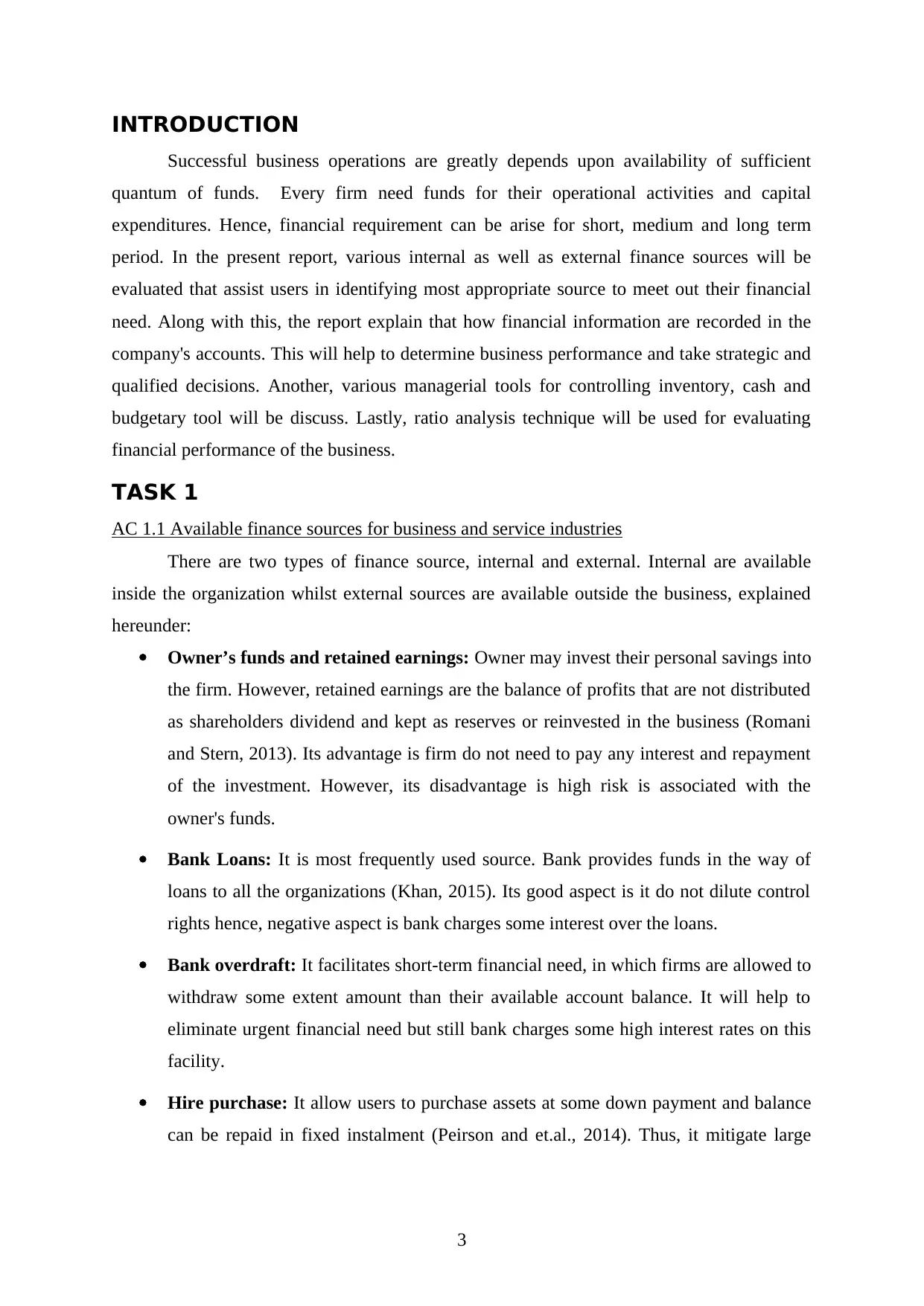
INTRODUCTION
Successful business operations are greatly depends upon availability of sufficient
quantum of funds. Every firm need funds for their operational activities and capital
expenditures. Hence, financial requirement can be arise for short, medium and long term
period. In the present report, various internal as well as external finance sources will be
evaluated that assist users in identifying most appropriate source to meet out their financial
need. Along with this, the report explain that how financial information are recorded in the
company's accounts. This will help to determine business performance and take strategic and
qualified decisions. Another, various managerial tools for controlling inventory, cash and
budgetary tool will be discuss. Lastly, ratio analysis technique will be used for evaluating
financial performance of the business.
TASK 1
AC 1.1 Available finance sources for business and service industries
There are two types of finance source, internal and external. Internal are available
inside the organization whilst external sources are available outside the business, explained
hereunder:
Owner’s funds and retained earnings: Owner may invest their personal savings into
the firm. However, retained earnings are the balance of profits that are not distributed
as shareholders dividend and kept as reserves or reinvested in the business (Romani
and Stern, 2013). Its advantage is firm do not need to pay any interest and repayment
of the investment. However, its disadvantage is high risk is associated with the
owner's funds.
Bank Loans: It is most frequently used source. Bank provides funds in the way of
loans to all the organizations (Khan, 2015). Its good aspect is it do not dilute control
rights hence, negative aspect is bank charges some interest over the loans.
Bank overdraft: It facilitates short-term financial need, in which firms are allowed to
withdraw some extent amount than their available account balance. It will help to
eliminate urgent financial need but still bank charges some high interest rates on this
facility.
Hire purchase: It allow users to purchase assets at some down payment and balance
can be repaid in fixed instalment (Peirson and et.al., 2014). Thus, it mitigate large
3
Successful business operations are greatly depends upon availability of sufficient
quantum of funds. Every firm need funds for their operational activities and capital
expenditures. Hence, financial requirement can be arise for short, medium and long term
period. In the present report, various internal as well as external finance sources will be
evaluated that assist users in identifying most appropriate source to meet out their financial
need. Along with this, the report explain that how financial information are recorded in the
company's accounts. This will help to determine business performance and take strategic and
qualified decisions. Another, various managerial tools for controlling inventory, cash and
budgetary tool will be discuss. Lastly, ratio analysis technique will be used for evaluating
financial performance of the business.
TASK 1
AC 1.1 Available finance sources for business and service industries
There are two types of finance source, internal and external. Internal are available
inside the organization whilst external sources are available outside the business, explained
hereunder:
Owner’s funds and retained earnings: Owner may invest their personal savings into
the firm. However, retained earnings are the balance of profits that are not distributed
as shareholders dividend and kept as reserves or reinvested in the business (Romani
and Stern, 2013). Its advantage is firm do not need to pay any interest and repayment
of the investment. However, its disadvantage is high risk is associated with the
owner's funds.
Bank Loans: It is most frequently used source. Bank provides funds in the way of
loans to all the organizations (Khan, 2015). Its good aspect is it do not dilute control
rights hence, negative aspect is bank charges some interest over the loans.
Bank overdraft: It facilitates short-term financial need, in which firms are allowed to
withdraw some extent amount than their available account balance. It will help to
eliminate urgent financial need but still bank charges some high interest rates on this
facility.
Hire purchase: It allow users to purchase assets at some down payment and balance
can be repaid in fixed instalment (Peirson and et.al., 2014). Thus, it mitigate large
3
⊘ This is a preview!⊘
Do you want full access?
Subscribe today to unlock all pages.

Trusted by 1+ million students worldwide

amount of expenditures at the time of purchase whereas disadvantage is instalment
contain some interest charges.
Trade credit: It facilitate businesses to make payment after a short duration of 30
days so that they can sell their products first and pay later to creditors. Cash discount
is not available in trade credit.
Government grants: Government provide funds in the form of grants that can be use
for specific purpose. Business do not need to repay it with no interest obligations
while it is available only for the specific objectives and may be time-consuming also.
Family, friends and relatives: They provide financial support without any extra cost.
However, it will available up to a limited extent hence, can not be use for longer
duration.
Share capital: Funds can be generated through issuing preference and ordinary shares
(Růčková, 2015). Advantage is it diversify business control to the shareholders while
negative aspect is firms has to pay return in the form of dividend to them.
Personal savings and hire purchase are the best source to acquire machinery costing
worth £50000. Through this, owner will be able to make down payment from personal
savings and balance amount of hire purchase can be paid in equal instalment.
AC 1.2 Ranges of method of generating income for a large chain restaurant
There are ample ways of generating money for large units of restaurants. Some of the
exciting and unique ideas to create more income to achieve a worldwide growth are
mentioned below Providing rent facility- Restaurants serves the facility of providing the space for
numerous events such as party,business events,product launching,seminars and the
like. Conducting seminars and workshops- Simultaneously,conducting demonstration
lessons on cooking in the said restaurant will help to grab the attention of localities.
This will result in growth of the restaurant along with brand building. Renegotiating the contracts- Alternatively, the company should put its efforts to
renegotiate all of its contracts such as the contracts with its vendors,suppliers,credit
card provider,landlord etc. As a result of this, the company surprisingly gets a huge
amount of saving.
4
contain some interest charges.
Trade credit: It facilitate businesses to make payment after a short duration of 30
days so that they can sell their products first and pay later to creditors. Cash discount
is not available in trade credit.
Government grants: Government provide funds in the form of grants that can be use
for specific purpose. Business do not need to repay it with no interest obligations
while it is available only for the specific objectives and may be time-consuming also.
Family, friends and relatives: They provide financial support without any extra cost.
However, it will available up to a limited extent hence, can not be use for longer
duration.
Share capital: Funds can be generated through issuing preference and ordinary shares
(Růčková, 2015). Advantage is it diversify business control to the shareholders while
negative aspect is firms has to pay return in the form of dividend to them.
Personal savings and hire purchase are the best source to acquire machinery costing
worth £50000. Through this, owner will be able to make down payment from personal
savings and balance amount of hire purchase can be paid in equal instalment.
AC 1.2 Ranges of method of generating income for a large chain restaurant
There are ample ways of generating money for large units of restaurants. Some of the
exciting and unique ideas to create more income to achieve a worldwide growth are
mentioned below Providing rent facility- Restaurants serves the facility of providing the space for
numerous events such as party,business events,product launching,seminars and the
like. Conducting seminars and workshops- Simultaneously,conducting demonstration
lessons on cooking in the said restaurant will help to grab the attention of localities.
This will result in growth of the restaurant along with brand building. Renegotiating the contracts- Alternatively, the company should put its efforts to
renegotiate all of its contracts such as the contracts with its vendors,suppliers,credit
card provider,landlord etc. As a result of this, the company surprisingly gets a huge
amount of saving.
4
Paraphrase This Document
Need a fresh take? Get an instant paraphrase of this document with our AI Paraphraser
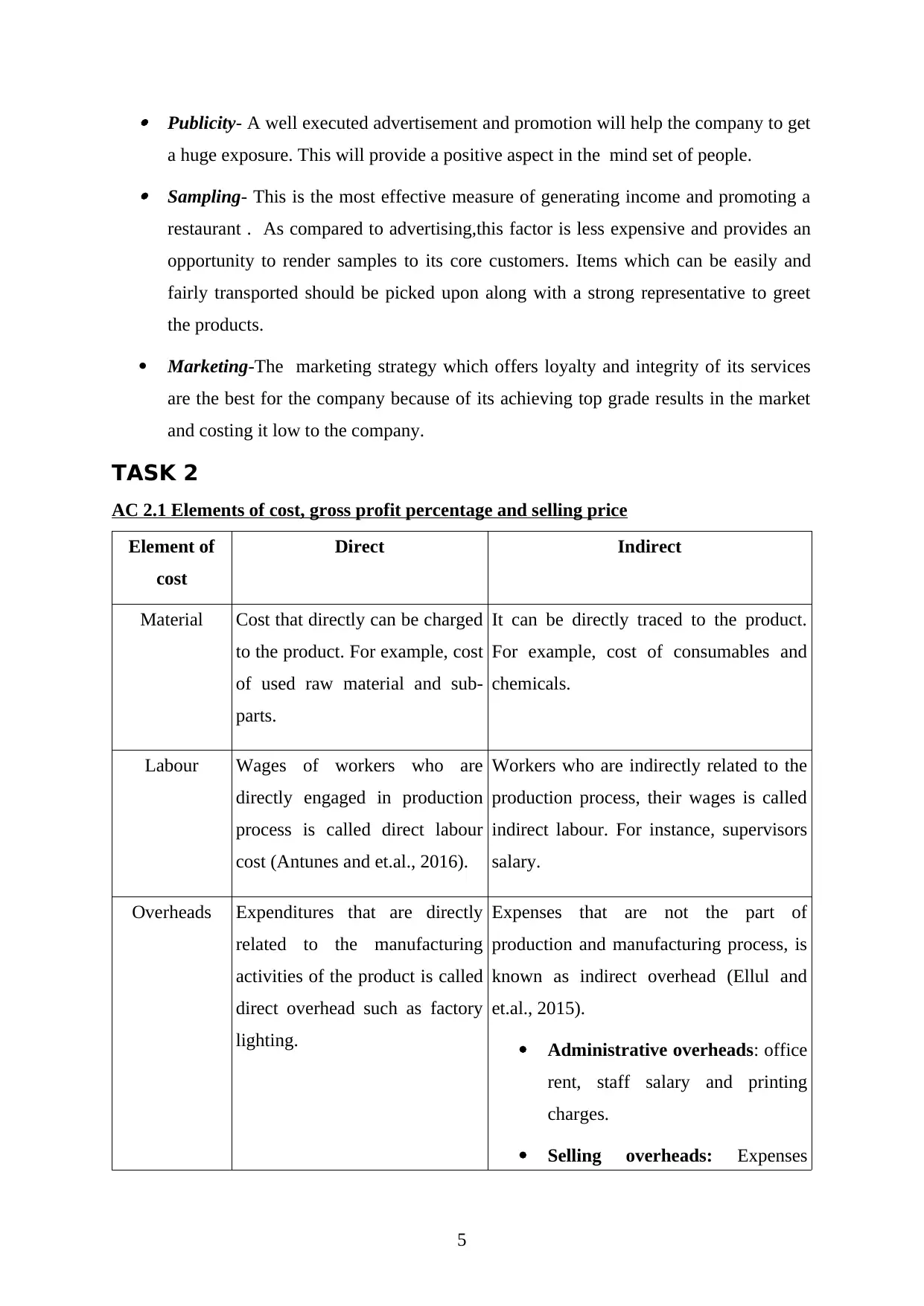
Publicity- A well executed advertisement and promotion will help the company to get
a huge exposure. This will provide a positive aspect in the mind set of people. Sampling- This is the most effective measure of generating income and promoting a
restaurant . As compared to advertising,this factor is less expensive and provides an
opportunity to render samples to its core customers. Items which can be easily and
fairly transported should be picked upon along with a strong representative to greet
the products.
Marketing-The marketing strategy which offers loyalty and integrity of its services
are the best for the company because of its achieving top grade results in the market
and costing it low to the company.
TASK 2
AC 2.1 Elements of cost, gross profit percentage and selling price
Element of
cost
Direct Indirect
Material Cost that directly can be charged
to the product. For example, cost
of used raw material and sub-
parts.
It can be directly traced to the product.
For example, cost of consumables and
chemicals.
Labour Wages of workers who are
directly engaged in production
process is called direct labour
cost (Antunes and et.al., 2016).
Workers who are indirectly related to the
production process, their wages is called
indirect labour. For instance, supervisors
salary.
Overheads Expenditures that are directly
related to the manufacturing
activities of the product is called
direct overhead such as factory
lighting.
Expenses that are not the part of
production and manufacturing process, is
known as indirect overhead (Ellul and
et.al., 2015).
Administrative overheads: office
rent, staff salary and printing
charges.
Selling overheads: Expenses
5
a huge exposure. This will provide a positive aspect in the mind set of people. Sampling- This is the most effective measure of generating income and promoting a
restaurant . As compared to advertising,this factor is less expensive and provides an
opportunity to render samples to its core customers. Items which can be easily and
fairly transported should be picked upon along with a strong representative to greet
the products.
Marketing-The marketing strategy which offers loyalty and integrity of its services
are the best for the company because of its achieving top grade results in the market
and costing it low to the company.
TASK 2
AC 2.1 Elements of cost, gross profit percentage and selling price
Element of
cost
Direct Indirect
Material Cost that directly can be charged
to the product. For example, cost
of used raw material and sub-
parts.
It can be directly traced to the product.
For example, cost of consumables and
chemicals.
Labour Wages of workers who are
directly engaged in production
process is called direct labour
cost (Antunes and et.al., 2016).
Workers who are indirectly related to the
production process, their wages is called
indirect labour. For instance, supervisors
salary.
Overheads Expenditures that are directly
related to the manufacturing
activities of the product is called
direct overhead such as factory
lighting.
Expenses that are not the part of
production and manufacturing process, is
known as indirect overhead (Ellul and
et.al., 2015).
Administrative overheads: office
rent, staff salary and printing
charges.
Selling overheads: Expenses
5
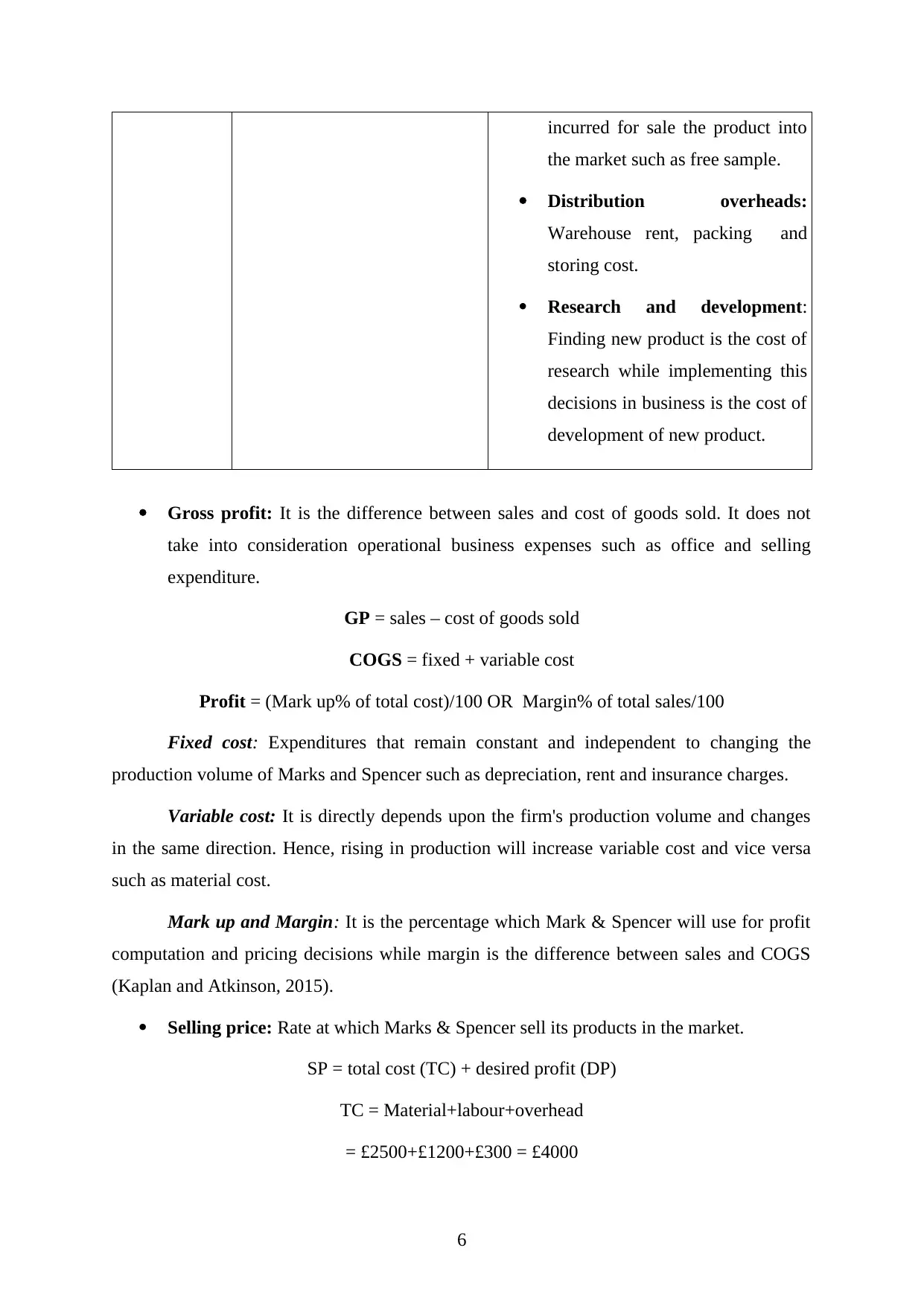
incurred for sale the product into
the market such as free sample.
Distribution overheads:
Warehouse rent, packing and
storing cost.
Research and development:
Finding new product is the cost of
research while implementing this
decisions in business is the cost of
development of new product.
Gross profit: It is the difference between sales and cost of goods sold. It does not
take into consideration operational business expenses such as office and selling
expenditure.
GP = sales – cost of goods sold
COGS = fixed + variable cost
Profit = (Mark up% of total cost)/100 OR Margin% of total sales/100
Fixed cost: Expenditures that remain constant and independent to changing the
production volume of Marks and Spencer such as depreciation, rent and insurance charges.
Variable cost: It is directly depends upon the firm's production volume and changes
in the same direction. Hence, rising in production will increase variable cost and vice versa
such as material cost.
Mark up and Margin: It is the percentage which Mark & Spencer will use for profit
computation and pricing decisions while margin is the difference between sales and COGS
(Kaplan and Atkinson, 2015).
Selling price: Rate at which Marks & Spencer sell its products in the market.
SP = total cost (TC) + desired profit (DP)
TC = Material+labour+overhead
= £2500+£1200+£300 = £4000
6
the market such as free sample.
Distribution overheads:
Warehouse rent, packing and
storing cost.
Research and development:
Finding new product is the cost of
research while implementing this
decisions in business is the cost of
development of new product.
Gross profit: It is the difference between sales and cost of goods sold. It does not
take into consideration operational business expenses such as office and selling
expenditure.
GP = sales – cost of goods sold
COGS = fixed + variable cost
Profit = (Mark up% of total cost)/100 OR Margin% of total sales/100
Fixed cost: Expenditures that remain constant and independent to changing the
production volume of Marks and Spencer such as depreciation, rent and insurance charges.
Variable cost: It is directly depends upon the firm's production volume and changes
in the same direction. Hence, rising in production will increase variable cost and vice versa
such as material cost.
Mark up and Margin: It is the percentage which Mark & Spencer will use for profit
computation and pricing decisions while margin is the difference between sales and COGS
(Kaplan and Atkinson, 2015).
Selling price: Rate at which Marks & Spencer sell its products in the market.
SP = total cost (TC) + desired profit (DP)
TC = Material+labour+overhead
= £2500+£1200+£300 = £4000
6
⊘ This is a preview!⊘
Do you want full access?
Subscribe today to unlock all pages.

Trusted by 1+ million students worldwide
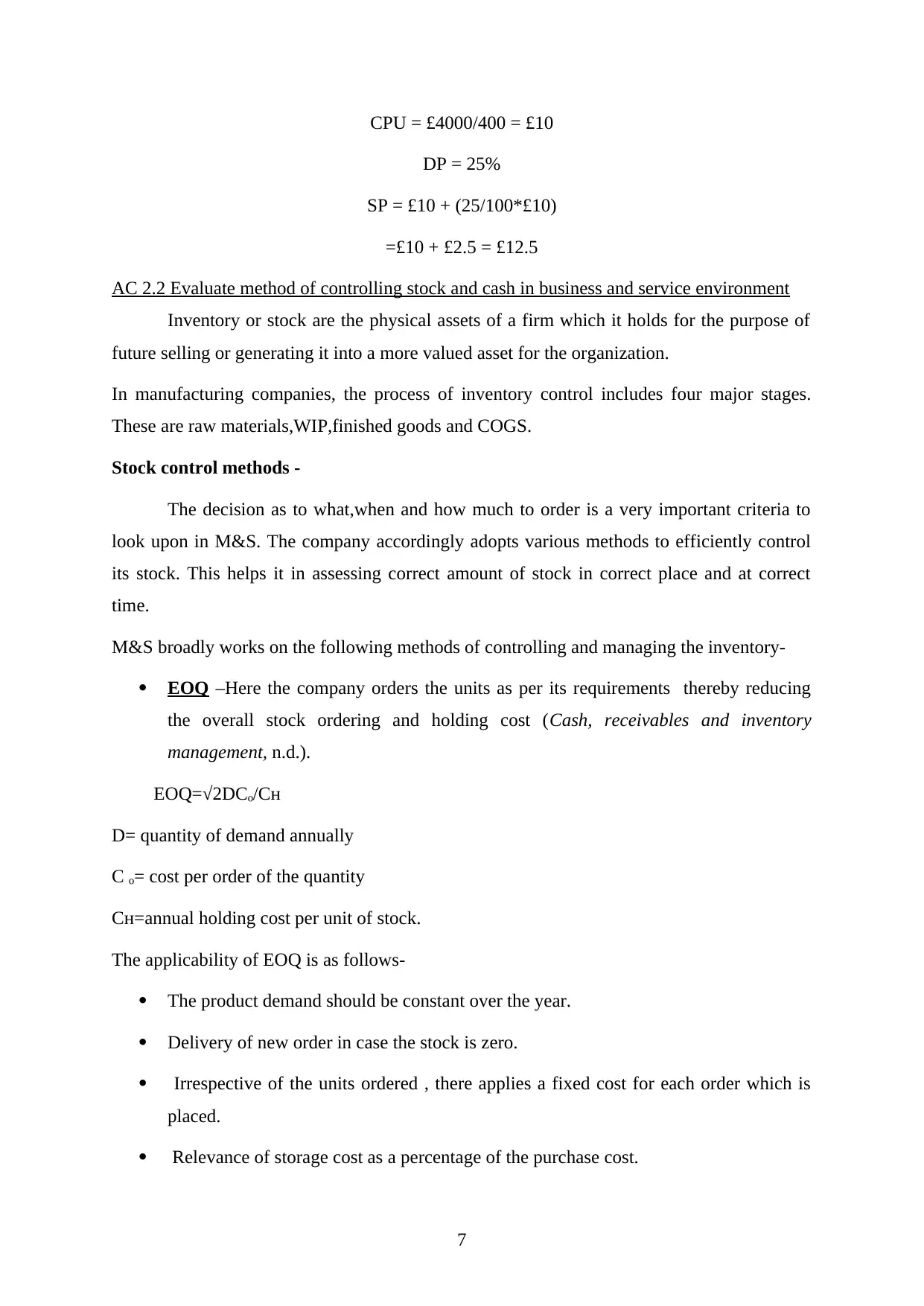
CPU = £4000/400 = £10
DP = 25%
SP = £10 + (25/100*£10)
=£10 + £2.5 = £12.5
AC 2.2 Evaluate method of controlling stock and cash in business and service environment
Inventory or stock are the physical assets of a firm which it holds for the purpose of
future selling or generating it into a more valued asset for the organization.
In manufacturing companies, the process of inventory control includes four major stages.
These are raw materials,WIP,finished goods and COGS.
Stock control methods -
The decision as to what,when and how much to order is a very important criteria to
look upon in M&S. The company accordingly adopts various methods to efficiently control
its stock. This helps it in assessing correct amount of stock in correct place and at correct
time.
M&S broadly works on the following methods of controlling and managing the inventory-
EOQ –Here the company orders the units as per its requirements thereby reducing
the overall stock ordering and holding cost (Cash, receivables and inventory
management, n.d.).
EOQ=√2DCₒ/Cʜ
D= quantity of demand annually
C ₒ= cost per order of the quantity
Cʜ=annual holding cost per unit of stock.
The applicability of EOQ is as follows-
The product demand should be constant over the year.
Delivery of new order in case the stock is zero.
Irrespective of the units ordered , there applies a fixed cost for each order which is
placed.
Relevance of storage cost as a percentage of the purchase cost.
7
DP = 25%
SP = £10 + (25/100*£10)
=£10 + £2.5 = £12.5
AC 2.2 Evaluate method of controlling stock and cash in business and service environment
Inventory or stock are the physical assets of a firm which it holds for the purpose of
future selling or generating it into a more valued asset for the organization.
In manufacturing companies, the process of inventory control includes four major stages.
These are raw materials,WIP,finished goods and COGS.
Stock control methods -
The decision as to what,when and how much to order is a very important criteria to
look upon in M&S. The company accordingly adopts various methods to efficiently control
its stock. This helps it in assessing correct amount of stock in correct place and at correct
time.
M&S broadly works on the following methods of controlling and managing the inventory-
EOQ –Here the company orders the units as per its requirements thereby reducing
the overall stock ordering and holding cost (Cash, receivables and inventory
management, n.d.).
EOQ=√2DCₒ/Cʜ
D= quantity of demand annually
C ₒ= cost per order of the quantity
Cʜ=annual holding cost per unit of stock.
The applicability of EOQ is as follows-
The product demand should be constant over the year.
Delivery of new order in case the stock is zero.
Irrespective of the units ordered , there applies a fixed cost for each order which is
placed.
Relevance of storage cost as a percentage of the purchase cost.
7
Paraphrase This Document
Need a fresh take? Get an instant paraphrase of this document with our AI Paraphraser
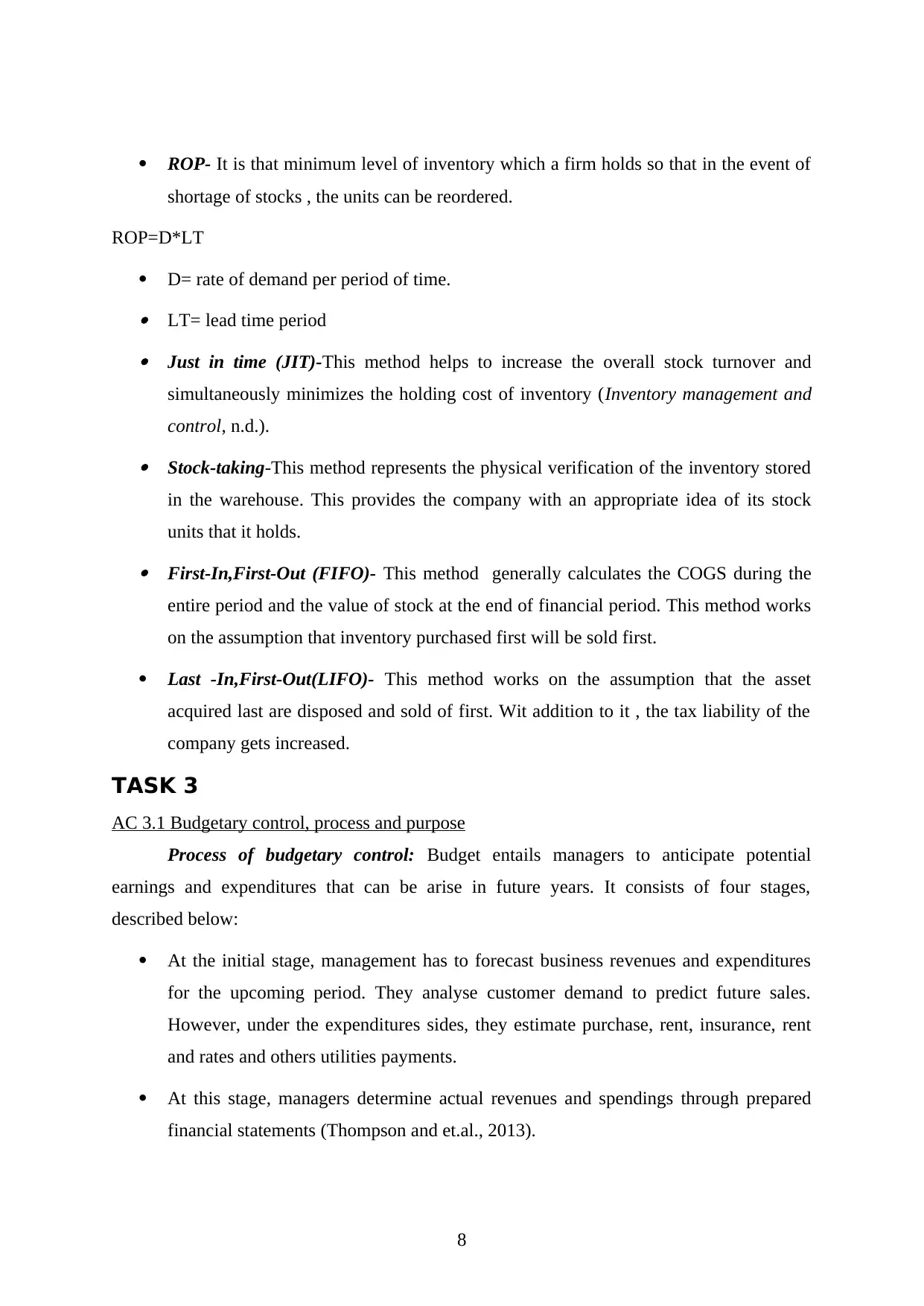
ROP- It is that minimum level of inventory which a firm holds so that in the event of
shortage of stocks , the units can be reordered.
ROP=D*LT
D= rate of demand per period of time. LT= lead time period Just in time (JIT)-This method helps to increase the overall stock turnover and
simultaneously minimizes the holding cost of inventory (Inventory management and
control, n.d.). Stock-taking-This method represents the physical verification of the inventory stored
in the warehouse. This provides the company with an appropriate idea of its stock
units that it holds. First-In,First-Out (FIFO)- This method generally calculates the COGS during the
entire period and the value of stock at the end of financial period. This method works
on the assumption that inventory purchased first will be sold first.
Last -In,First-Out(LIFO)- This method works on the assumption that the asset
acquired last are disposed and sold of first. Wit addition to it , the tax liability of the
company gets increased.
TASK 3
AC 3.1 Budgetary control, process and purpose
Process of budgetary control: Budget entails managers to anticipate potential
earnings and expenditures that can be arise in future years. It consists of four stages,
described below:
At the initial stage, management has to forecast business revenues and expenditures
for the upcoming period. They analyse customer demand to predict future sales.
However, under the expenditures sides, they estimate purchase, rent, insurance, rent
and rates and others utilities payments.
At this stage, managers determine actual revenues and spendings through prepared
financial statements (Thompson and et.al., 2013).
8
shortage of stocks , the units can be reordered.
ROP=D*LT
D= rate of demand per period of time. LT= lead time period Just in time (JIT)-This method helps to increase the overall stock turnover and
simultaneously minimizes the holding cost of inventory (Inventory management and
control, n.d.). Stock-taking-This method represents the physical verification of the inventory stored
in the warehouse. This provides the company with an appropriate idea of its stock
units that it holds. First-In,First-Out (FIFO)- This method generally calculates the COGS during the
entire period and the value of stock at the end of financial period. This method works
on the assumption that inventory purchased first will be sold first.
Last -In,First-Out(LIFO)- This method works on the assumption that the asset
acquired last are disposed and sold of first. Wit addition to it , the tax liability of the
company gets increased.
TASK 3
AC 3.1 Budgetary control, process and purpose
Process of budgetary control: Budget entails managers to anticipate potential
earnings and expenditures that can be arise in future years. It consists of four stages,
described below:
At the initial stage, management has to forecast business revenues and expenditures
for the upcoming period. They analyse customer demand to predict future sales.
However, under the expenditures sides, they estimate purchase, rent, insurance, rent
and rates and others utilities payments.
At this stage, managers determine actual revenues and spendings through prepared
financial statements (Thompson and et.al., 2013).
8
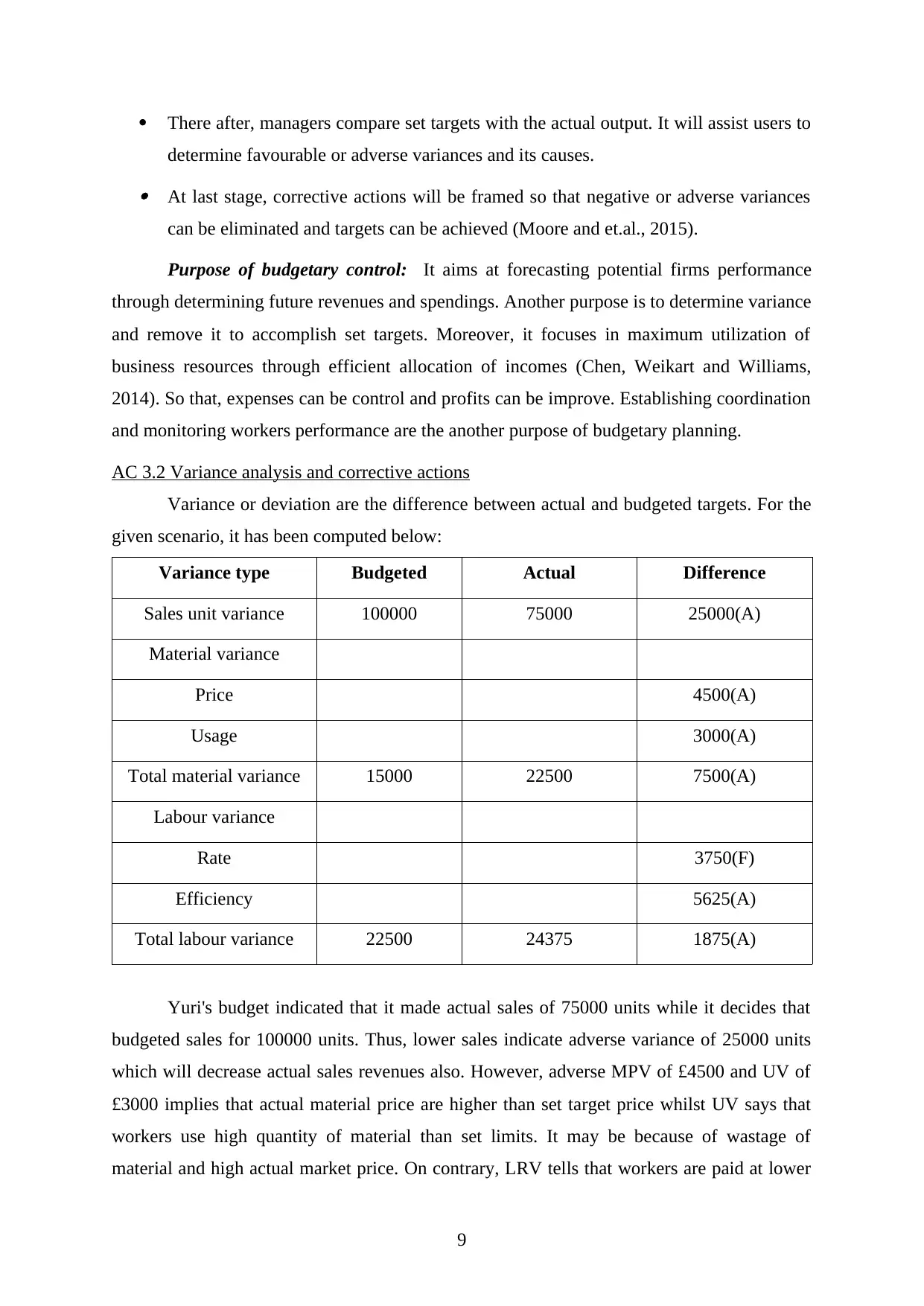
There after, managers compare set targets with the actual output. It will assist users to
determine favourable or adverse variances and its causes. At last stage, corrective actions will be framed so that negative or adverse variances
can be eliminated and targets can be achieved (Moore and et.al., 2015).
Purpose of budgetary control: It aims at forecasting potential firms performance
through determining future revenues and spendings. Another purpose is to determine variance
and remove it to accomplish set targets. Moreover, it focuses in maximum utilization of
business resources through efficient allocation of incomes (Chen, Weikart and Williams,
2014). So that, expenses can be control and profits can be improve. Establishing coordination
and monitoring workers performance are the another purpose of budgetary planning.
AC 3.2 Variance analysis and corrective actions
Variance or deviation are the difference between actual and budgeted targets. For the
given scenario, it has been computed below:
Variance type Budgeted Actual Difference
Sales unit variance 100000 75000 25000(A)
Material variance
Price 4500(A)
Usage 3000(A)
Total material variance 15000 22500 7500(A)
Labour variance
Rate 3750(F)
Efficiency 5625(A)
Total labour variance 22500 24375 1875(A)
Yuri's budget indicated that it made actual sales of 75000 units while it decides that
budgeted sales for 100000 units. Thus, lower sales indicate adverse variance of 25000 units
which will decrease actual sales revenues also. However, adverse MPV of £4500 and UV of
£3000 implies that actual material price are higher than set target price whilst UV says that
workers use high quantity of material than set limits. It may be because of wastage of
material and high actual market price. On contrary, LRV tells that workers are paid at lower
9
determine favourable or adverse variances and its causes. At last stage, corrective actions will be framed so that negative or adverse variances
can be eliminated and targets can be achieved (Moore and et.al., 2015).
Purpose of budgetary control: It aims at forecasting potential firms performance
through determining future revenues and spendings. Another purpose is to determine variance
and remove it to accomplish set targets. Moreover, it focuses in maximum utilization of
business resources through efficient allocation of incomes (Chen, Weikart and Williams,
2014). So that, expenses can be control and profits can be improve. Establishing coordination
and monitoring workers performance are the another purpose of budgetary planning.
AC 3.2 Variance analysis and corrective actions
Variance or deviation are the difference between actual and budgeted targets. For the
given scenario, it has been computed below:
Variance type Budgeted Actual Difference
Sales unit variance 100000 75000 25000(A)
Material variance
Price 4500(A)
Usage 3000(A)
Total material variance 15000 22500 7500(A)
Labour variance
Rate 3750(F)
Efficiency 5625(A)
Total labour variance 22500 24375 1875(A)
Yuri's budget indicated that it made actual sales of 75000 units while it decides that
budgeted sales for 100000 units. Thus, lower sales indicate adverse variance of 25000 units
which will decrease actual sales revenues also. However, adverse MPV of £4500 and UV of
£3000 implies that actual material price are higher than set target price whilst UV says that
workers use high quantity of material than set limits. It may be because of wastage of
material and high actual market price. On contrary, LRV tells that workers are paid at lower
9
⊘ This is a preview!⊘
Do you want full access?
Subscribe today to unlock all pages.

Trusted by 1+ million students worldwide
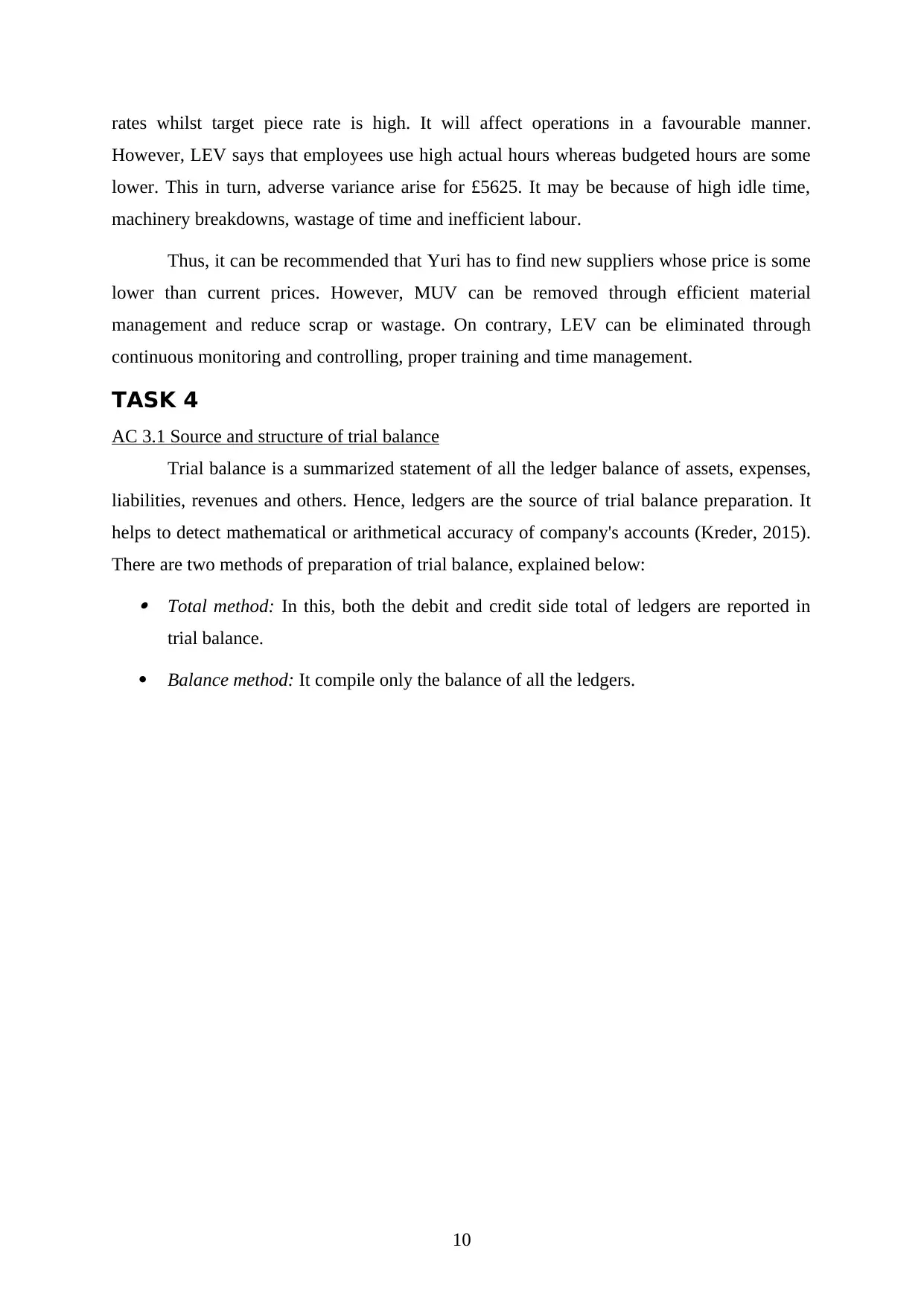
rates whilst target piece rate is high. It will affect operations in a favourable manner.
However, LEV says that employees use high actual hours whereas budgeted hours are some
lower. This in turn, adverse variance arise for £5625. It may be because of high idle time,
machinery breakdowns, wastage of time and inefficient labour.
Thus, it can be recommended that Yuri has to find new suppliers whose price is some
lower than current prices. However, MUV can be removed through efficient material
management and reduce scrap or wastage. On contrary, LEV can be eliminated through
continuous monitoring and controlling, proper training and time management.
TASK 4
AC 3.1 Source and structure of trial balance
Trial balance is a summarized statement of all the ledger balance of assets, expenses,
liabilities, revenues and others. Hence, ledgers are the source of trial balance preparation. It
helps to detect mathematical or arithmetical accuracy of company's accounts (Kreder, 2015).
There are two methods of preparation of trial balance, explained below: Total method: In this, both the debit and credit side total of ledgers are reported in
trial balance.
Balance method: It compile only the balance of all the ledgers.
10
However, LEV says that employees use high actual hours whereas budgeted hours are some
lower. This in turn, adverse variance arise for £5625. It may be because of high idle time,
machinery breakdowns, wastage of time and inefficient labour.
Thus, it can be recommended that Yuri has to find new suppliers whose price is some
lower than current prices. However, MUV can be removed through efficient material
management and reduce scrap or wastage. On contrary, LEV can be eliminated through
continuous monitoring and controlling, proper training and time management.
TASK 4
AC 3.1 Source and structure of trial balance
Trial balance is a summarized statement of all the ledger balance of assets, expenses,
liabilities, revenues and others. Hence, ledgers are the source of trial balance preparation. It
helps to detect mathematical or arithmetical accuracy of company's accounts (Kreder, 2015).
There are two methods of preparation of trial balance, explained below: Total method: In this, both the debit and credit side total of ledgers are reported in
trial balance.
Balance method: It compile only the balance of all the ledgers.
10
Paraphrase This Document
Need a fresh take? Get an instant paraphrase of this document with our AI Paraphraser
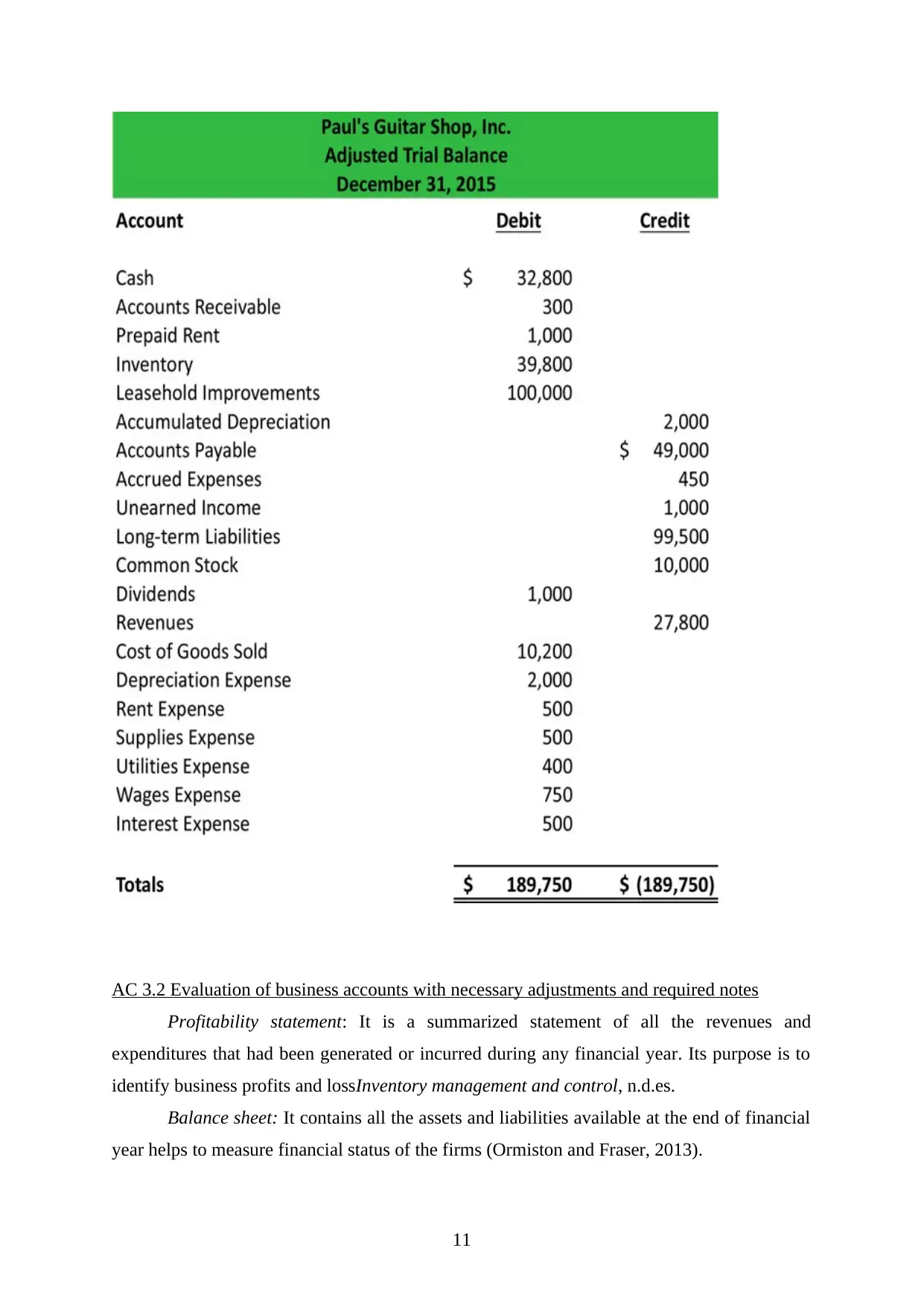
AC 3.2 Evaluation of business accounts with necessary adjustments and required notes
Profitability statement: It is a summarized statement of all the revenues and
expenditures that had been generated or incurred during any financial year. Its purpose is to
identify business profits and lossInventory management and control, n.d.es.
Balance sheet: It contains all the assets and liabilities available at the end of financial
year helps to measure financial status of the firms (Ormiston and Fraser, 2013).
11
Profitability statement: It is a summarized statement of all the revenues and
expenditures that had been generated or incurred during any financial year. Its purpose is to
identify business profits and lossInventory management and control, n.d.es.
Balance sheet: It contains all the assets and liabilities available at the end of financial
year helps to measure financial status of the firms (Ormiston and Fraser, 2013).
11
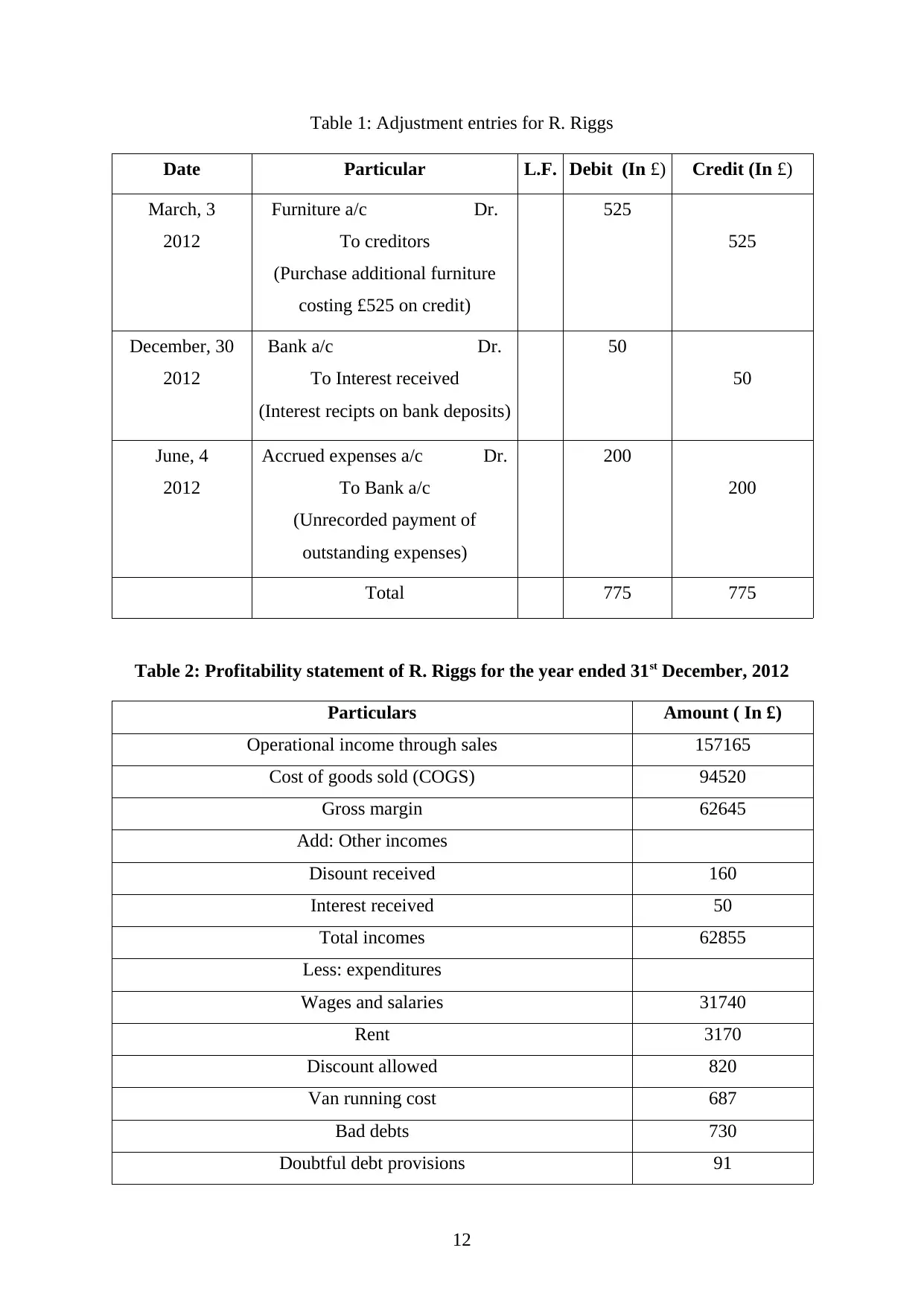
Table 1: Adjustment entries for R. Riggs
Date Particular L.F. Debit (In £) Credit (In £)
March, 3
2012
Furniture a/c Dr.
To creditors
(Purchase additional furniture
costing £525 on credit)
525
525
December, 30
2012
Bank a/c Dr.
To Interest received
(Interest recipts on bank deposits)
50
50
June, 4
2012
Accrued expenses a/c Dr.
To Bank a/c
(Unrecorded payment of
outstanding expenses)
200
200
Total 775 775
Table 2: Profitability statement of R. Riggs for the year ended 31st December, 2012
Particulars Amount ( In £)
Operational income through sales 157165
Cost of goods sold (COGS) 94520
Gross margin 62645
Add: Other incomes
Disount received 160
Interest received 50
Total incomes 62855
Less: expenditures
Wages and salaries 31740
Rent 3170
Discount allowed 820
Van running cost 687
Bad debts 730
Doubtful debt provisions 91
12
Date Particular L.F. Debit (In £) Credit (In £)
March, 3
2012
Furniture a/c Dr.
To creditors
(Purchase additional furniture
costing £525 on credit)
525
525
December, 30
2012
Bank a/c Dr.
To Interest received
(Interest recipts on bank deposits)
50
50
June, 4
2012
Accrued expenses a/c Dr.
To Bank a/c
(Unrecorded payment of
outstanding expenses)
200
200
Total 775 775
Table 2: Profitability statement of R. Riggs for the year ended 31st December, 2012
Particulars Amount ( In £)
Operational income through sales 157165
Cost of goods sold (COGS) 94520
Gross margin 62645
Add: Other incomes
Disount received 160
Interest received 50
Total incomes 62855
Less: expenditures
Wages and salaries 31740
Rent 3170
Discount allowed 820
Van running cost 687
Bad debts 730
Doubtful debt provisions 91
12
⊘ This is a preview!⊘
Do you want full access?
Subscribe today to unlock all pages.

Trusted by 1+ million students worldwide
1 out of 19